|
| <- prev |
| Operation of Network Boot Host-> Operation of each function |
Operation of Each function
Host Status
Show the current setting status of each function.
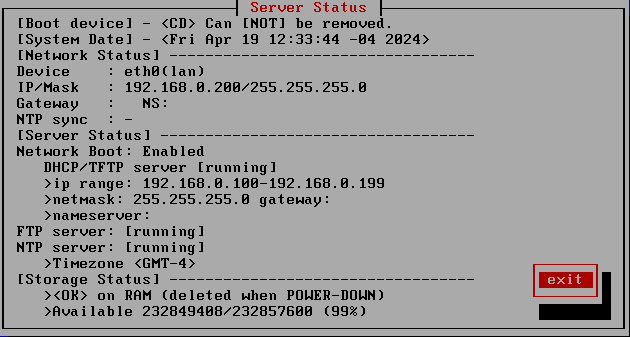
[Boot Device]
Displays the boot device and information on whether it can be removed .
<CD>: Booting from CD
<usb flash>: Booting from USB flash drive
Can be Removed: The boot CD/USB memory can be removed. The system will
continue to operate even if it is removed.
Can [NOT] be removed: The boot
CD/USB memory cannot be removed. It is used for network boot programs, log
writing, etc.
[System Date]
Current system date and time. "-04"(example) before the year is the time
zone.
[Network Status]
Displays the current network address settings, etc.
Also, if the NTP
client is enabled, the setting status as an NTP client will be displayed.
If "Status:NG (N:Error code)", an error has occurred in the network
settings.
| Error code |
Contents |
Troubleshooting |
| Error that may occurs | ||
|
(N3) No network device found |
The network device is not enabled because there is no corresponding network driver. |
The network interface card installed in your PC may not be supported by your
"Green Pepper PRO" version. Or, no valid network interface was found. |
|
(N20) Address is not set(DHCP) Address is not set(static) |
The IP address could not be set. In the case of DHCP, the address cannot be obtained because the network cable is not connected or the DHCP server cannot be found. |
When specifying an IP address by DHCP, it often occurs when the IP address
cannot be obtained because the DHCP server cannot be found or the DHCP
server does not respond. Please check the network route to the DHCP server and check the operation of the DHCP server. If you change the network route (cable, hub, etc.) or DHCP server side and try to connect again, restart "Green Pepper PRO" system or perform "Utilities"/"Rescan disks /Reset network". In the case of IP address setting with a fixed value, the specified address is incorrect, etc. Check the IP address / subnet mask settings. |
| The following rarely occurs | ||
|
(N1) Confing file not found |
The network configuration file cannot be found. | |
|
(N2) Confing file read error |
An error occurred while reading the network configuration file. | |
|
(N10) No ip/netmask in config |
The fixed IP address (ipv4) and subnet mask values are not set. | |
|
(N11) Bad ip(ipv4) address |
Specified fixed IP address (ipv4) is incorrect. | |
|
(N12) Bad subnet mask(ipv4) |
Specified subnet mask (ipv4) is incorrect. | |
|
(N13) Bad gateway address(ipv4) |
Specified gateway address (ipv4) is incorrect. | |
[Server Status]
Displays the execution status of server processes.
Network Boot:
Enabled / Disabled
DHCP/TFTP server
[runiing]:
The server process required for network boot is running.
The IP address distributed by the DHCP server will be displayed.
Error: An error has occurred. An error message will be displayed.
FTP server:
Disabled/ Running
Error: An error
has occurred. An error message will be displayed.
NTP server:
Disabled/ Running
Timezone is displayed
Error: An error has occurred. An error message will be displayed.
[Storage Status]
Displays the storage status.
<OK>
Settings are being made. The currently assigned device is
displayed in XXXX.
USB flash drive (boot): Assigned to the USB flash drive used for
booting
RAM (deleted when POWER-DOWN): Assigned to memory (RAM) as
storage.
Saved log files, etc. will be deleted when the power
is turned off.
[HDD/SSD model number]: Assign HDD/SSD as storage.
Available xxxxx/xxxxxxx (xx%):
Indicates the available
capacity/total capacity (usage rate) of storage.
However, in the case of a
RAM drive, it cannot be used to its full capacity because it is shared with
other systems and execution programs.
Erase Logs
When the FTP server function is enabled and erase logs of the erase program are saved, a list and contents of erase logs will be displayed.
If you are using a USB flash drive as storage, you can remove the USB flash
drive, connect it to a Windows PC, etc., and copy or delete the contents.
If you are using an internal disk, you will need to connect another PC via FTP
to copy or delete.
*The maximum number of files displayed is 1024.
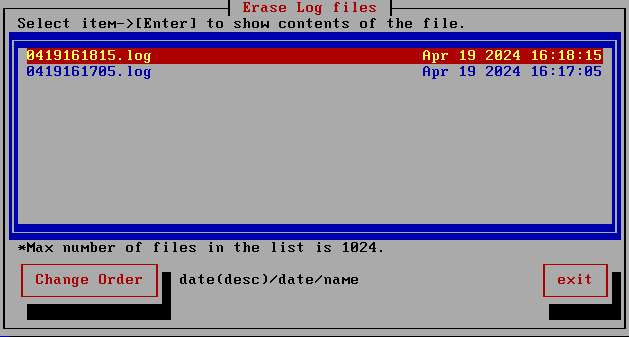
File selection/display
Select a file using the up and down arrow keys and press [enter] to display
the file contents.
Change order
When you press [Change order], sorted by,
Date (descending)->Date
(ascending)->File name
System Logs
Check logs related to the system, such as DHCP lease status, TFTP
(network boot) download status, host/network settings/error status, etc.
Select the log to display and press [enter] to display the contents.
*The displayed file content is up to 65536 bytes.
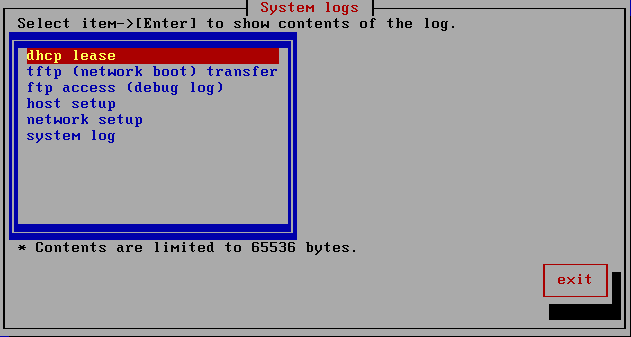
DHCP lease
Displays the address distribution status on the DHCP server.

The date and time (time of expiry: 12 hours after distribution), distribution destination MAC address, distribution IP address, etc. are displayed.
tftp (network boot) transfer
Displays the file transfer status using tftp used for network boot.
ftp access (debug log)
Display detailed ftp access logs.
However, nothing is displayed in the
initial state.
In "Host process control", temporarily [stop] the FTP
process and then select [Debug Run] to obtain access logs.

Host setup
This is the setting status of the network boot host. If you have any
problems, please let us know.
Network setup
This is the setting status of the network. If you have any problems, please
let us know.
System Log
Detailed log for the entire system.
Storage Configuration
Configure storage
to be used to store erase logs on the FTP server.
If you do not use an FTP
server, leave it in its initial state and do not need to make any settings.
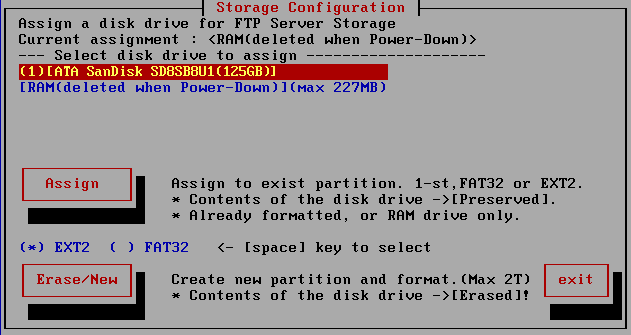
The following devices can be used as storage.
・USB flash drive used for startup.
The
notation is "USB flash drive (boot)".
・Uses memory (RAM) as storage. Saved
log files, etc. will be deleted when the power is turned off.
The notation is "RAM (deleted when POWER-DOWN)".
・HDD/SSD such as SATA,
NVMe, USB connection.
The notation is the model
number of the disk drive.
When used, it will be
formatted as EXT2/FAT32 and its contents will be erased.
Also, the maximum capacity is limited to 2T (2 terabytes).
(Disk drives of 2T or more can also be used, but the capacity used will be 2T)
Current Assignment
Displaying currently assigned devices.
[Assign]
When assigning to "USB flash drive (boot)", "RAM (deleted when POWER-DOWN)",
or if the first partition of the disk is already formatted as FAT32/EXT2, do
"Assign ” process.
The current disk contents are preserved (not erased),
except for assigning to RAM.
[Erase/New]
Perform this process when newly assigning to HDD/SSD.
Please note that
the contents of the disk drive will be
erased.
Select EXT2 or FAT32 as the formatting method. EXT2 is a format commonly
used on Linux, but cannot be read from Windows. FAT32 can be read from
Windows, so if you want to retrieve log files by connecting to Windows PC,
please select FAT32.
The partitions will be created and the first
partition will be used.
Host Process Control
Controls the
suspension and restart of host processes running on the network boot host.
It can be used to temporarily stop [Network Boot Process] (DHCP) when
connecting to an existing network.
FTP also allows you to leave detailed
access logs by selecting [Stop]->[DebugRun].
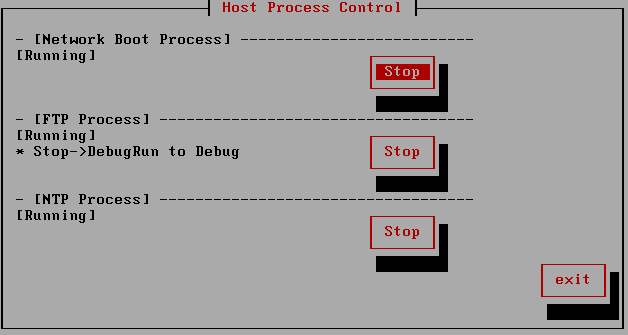
Operation of Each function - Utility
Save Hardware Information
to Erase Log Area
Writes detailed hardware information to the erase log area for
problem investigation.

The written hardware information can be accessed from the "Erase Logs" menu as shown above.
hwinfo_xxxx.txt
will be the name.
Save Screenshot to Erase Log Area
Take a screenshot and write the file to the erase log area.

It is used when there is a problem with processing, when you want to save screen information in-house as a processing record, or when you want to prepare manuals, etc.
If written, the file name will be "ddhhMMss.stx" (day, hours, minutes,
seconds).
This file is a Linux hardcopy file. Please use the "stx2bmp.exe"
program included with the product to convert it to an image file (*.bmp).
Rescan Disks/Reset Network
Execute this command to reconfigure the settings when the disk/net
environment changes, such as by connecting or disconnecting a USB disk drive
or reconnecting a network cable.
The installation status of drivers and network status are displayed on the
screen, so you can use it to check the status.
When the process is
finished, "press[enter]" will be displayed at the end, so press the [enter]
key.
PING Test
Perform a PING test to confirm network connectivity.
Enter the IP address or host name for which you want to test the
connection, and select [PING].
If "ping test OK" is displayed, a basic
connection with the PC has been established.
* When connecting by host name, the name server must be set correctly and
the name server must be able to resolve the name.
* Note: Some PC
firewalls may block PING responses. In that case, you may be able to connect
even if the connection fails here.